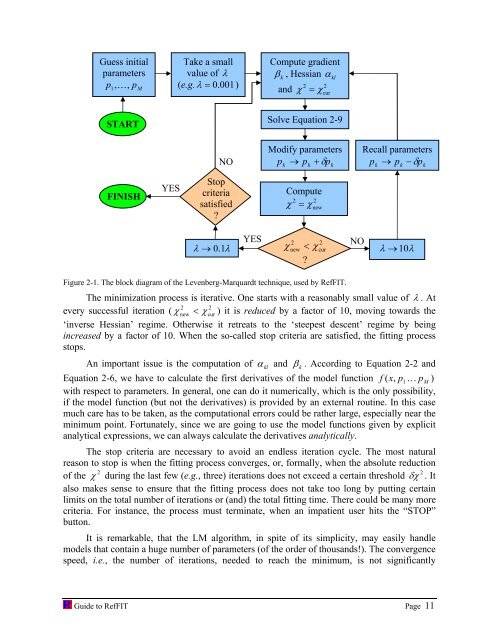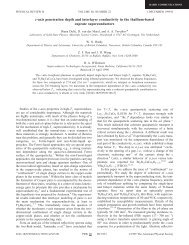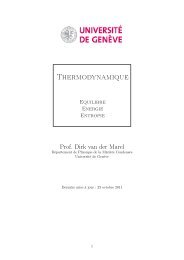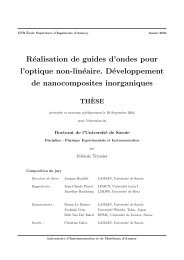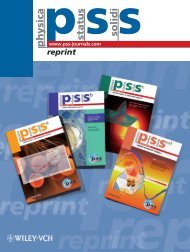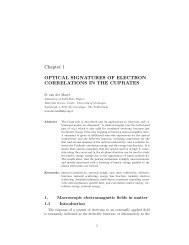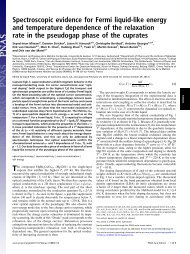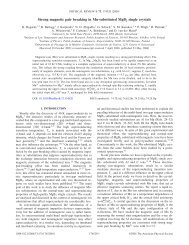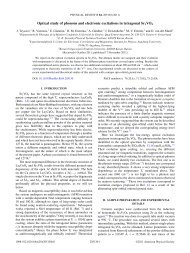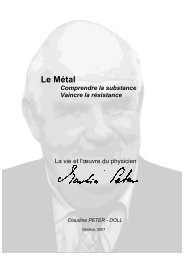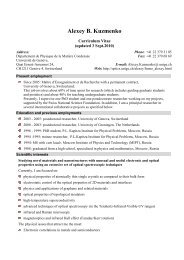software to fit optical spectra - Quantum Materials Group
software to fit optical spectra - Quantum Materials Group
software to fit optical spectra - Quantum Materials Group
Create successful ePaper yourself
Turn your PDF publications into a flip-book with our unique Google optimized e-Paper software.
Guess initial<br />
parameters<br />
p , , p<br />
1 K<br />
START<br />
M<br />
FINISH<br />
YES<br />
Take a small<br />
value of λ<br />
(e.g. λ = 0.<br />
001)<br />
Figure 2-1. The block diagram of the Levenberg-Marquardt technique, used by RefFIT.<br />
NO<br />
S<strong>to</strong>p<br />
criteria<br />
satisfied<br />
?<br />
λ → 0.<br />
1λ<br />
Compute gradient<br />
β k , Hessian α kl<br />
2 2<br />
and χ = χ<br />
YES 2<br />
χ new<br />
2<br />
< χ cur<br />
?<br />
NO<br />
The minimization process is iterative. One starts with a reasonably small value of λ . At<br />
2 2<br />
every successful iteration ( χ new < χ cur ) it is reduced by a fac<strong>to</strong>r of 10, moving <strong>to</strong>wards the<br />
‘inverse Hessian’ regime. Otherwise it retreats <strong>to</strong> the ‘steepest descent’ regime by being<br />
increased by a fac<strong>to</strong>r of 10. When the so-called s<strong>to</strong>p criteria are satisfied, the <strong>fit</strong>ting process<br />
s<strong>to</strong>ps.<br />
An important issue is the computation of α kl and β k . According <strong>to</strong> Equation 2-2 and<br />
Equation 2-6, we have <strong>to</strong> calculate the first derivatives of the model function f ( x,<br />
p1<br />
K pM<br />
)<br />
with respect <strong>to</strong> parameters. In general, one can do it numerically, which is the only possibility,<br />
if the model function (but not the derivatives) is provided by an external routine. In this case<br />
much care has <strong>to</strong> be taken, as the computational errors could be rather large, especially near the<br />
minimum point. Fortunately, since we are going <strong>to</strong> use the model functions given by explicit<br />
analytical expressions, we can always calculate the derivatives analytically.<br />
The s<strong>to</strong>p criteria are necessary <strong>to</strong> avoid an endless iteration cycle. The most natural<br />
reason <strong>to</strong> s<strong>to</strong>p is when the <strong>fit</strong>ting process converges, or, formally, when the absolute reduction<br />
2<br />
2<br />
of the χ during the last few (e.g., three) iterations does not exceed a certain threshold δχ . It<br />
also makes sense <strong>to</strong> ensure that the <strong>fit</strong>ting process does not take <strong>to</strong>o long by putting certain<br />
limits on the <strong>to</strong>tal number of iterations or (and) the <strong>to</strong>tal <strong>fit</strong>ting time. There could be many more<br />
criteria. For instance, the process must terminate, when an impatient user hits the “STOP”<br />
but<strong>to</strong>n.<br />
It is remarkable, that the LM algorithm, in spite of its simplicity, may easily handle<br />
models that contain a huge number of parameters (of the order of thousands!). The convergence<br />
speed, i.e., the number of iterations, needed <strong>to</strong> reach the minimum, is not significantly<br />
Guide <strong>to</strong> RefFIT Page 11<br />
cur<br />
Solve Equation 2-9<br />
Modify parameters<br />
p → p + δp<br />
k<br />
k<br />
Compute<br />
2 2<br />
χ = χ<br />
new<br />
k<br />
Recall parameters<br />
p → p − δp<br />
k<br />
k<br />
λ → 10λ<br />
k


